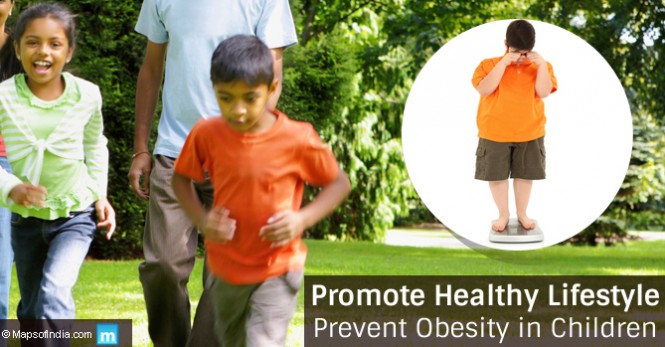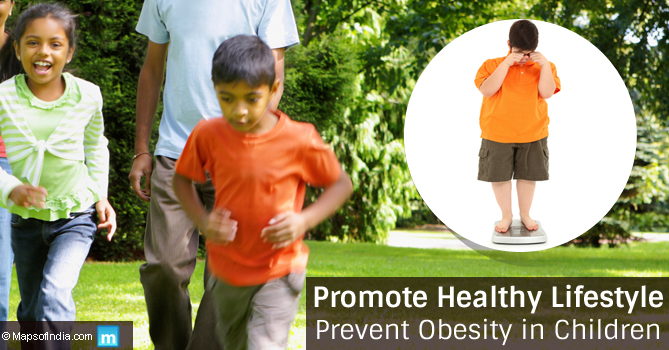 According to statistics, about 10-20% of children in India are obese. This number increases to up to 30% among adolescents. About 2/3rd of children with obesity continue to be obese in adult life. While obesity was once considered to be a sign of affluence in India, it is now being observed even among the middle and lower middle class populations.
According to statistics, about 10-20% of children in India are obese. This number increases to up to 30% among adolescents. About 2/3rd of children with obesity continue to be obese in adult life. While obesity was once considered to be a sign of affluence in India, it is now being observed even among the middle and lower middle class populations.
While body-mass index (BMI) is used traditionally as a measure of obesity in adults, it is found to be inappropriate in children. It has to be considered with reference to the child’s age and sex for a more accurate reading. Other measures such as skin-fold thickness, waist-hip ratio, waist circumference, and various scanning techniques are also used to measure obesity in children. Generally, if your child has more than usual flabbiness in arms, thighs and abdomen, if he or she huffs and puffs after minimal physical exertion, or struggles to keep pace with other children, then he or she is likely to have obesity.
What causes obesity in children?
Heredity: Just as tall parents have tall children, overweight parents are highly likely to have overweight children. Up to 1/4th of cases of childhood obesity are said to be contributed by hereditary factors. Rarely, certain genetic conditions such as Prader-Willi syndrome are associated with childhood obesity.
Diet: Nowadays, a day out means going to the nearest mall and gorging on high calorie food stuffs in the food court. Eating out has become a necessity these days with both parents working; children are fed sugary and fatty substances, which are high on calorific value, but low on nutritive content.
Lifestyle: The child’s growing environment plays a huge role. Often parents are ignorant about their children being overweight, as in their eyes they are perfect. This denial takes the form of parental praise of the child for being ‘healthy’ (which actually means overweight). Children are used to extra levels of comfort these days as everything is provided on a platter by doting parents. Gone are the days of walking to the local market; they are more used to travelling by car or bike. Exercise in the form of outdoor play is missing in the activity sheet of children due to several reasons. The number of gadgets that surround children these days is astounding. They spend more time staring at the screens of mobile phones, TVs, computers or playing video games, rather than going out to play games that involve physical effort. The lack of playing spaces in urban areas is also a factor in decreasing play time. School homework and studying hard for that extra mark has also resulted in the phenomenon of ‘all work and no play’.
What are the effects of early obesity?
A number of physical health problems are associated with childhood obesity. Predilection to cardiovascular diseases, high blood pressure, type 2 diabetes, gall stones, worsening of asthma, polycystic ovaries in girls, obstructive sleep apnea, and sleep disturbances are known to occur in obese children. Besides, being obese is a cause of low self-esteem, especially if the child is subjected to ridicule from friends at school. Fear of rejection, withdrawal from social activities, anxiety and depression are associated with being obese at an early age.
What can be done to reduce obesity in children?
• Watch the diet: Generally the dietary advice given in some of my earlier articles (heart health and Mediterranean diet) holds good in tackling childhood obesity as well. The idea is to cut down on carbohydrates and fats in the diet, and increase the intake of water, fruits, vegetables and nuts. Use high calorie foods as treats once in a while or to encourage good behaviour.
• Days out: It doesn’t have to be malls or movies all the time. Go out for picnics, trekking, and outdoor activities. The idea is to make the activity fun-based and grueling at the same time.
• Give tasks: It is okay to ask children to help in the kitchen or do household chores such as cleaning. Dietary treats and days out can then be used as rewards for completing the given task. Apart from physical effort, such activities also help bring about a sense of responsibility and discipline in children.
• Encourage physical activities: Walking is a terrific exercise which can be undertaken by both parents and children while going out to the local shop or a friend’s house. Allow for regular play time in the child’s daily schedule in the middle of studies. This would then provide both exercise and the much needed break from studies, apart from increasing concentration. Yoga is a great method of improving physical fitness, concentration and calmness in children. Having a regular physically exerting hobby such as swimming and cycling is also very good in reducing the excess flab.
• Reduce screen time: Restrict TV viewing and access to mobiles and video games to less than two hours in a day. These should only be used as a means of information gathering, for communicating with others, or as breaks from studies.
• School issues: Make sure that the school in which you are enrolling your child has a playground and a dedicated period in the day’s timetable that allows for games or sports. Encourage the child to participate in the sport activities of the school. Also make sure that the child is not overburdened with home work and a needless emphasis on rote learning and knowledge building.
• Change your attitude: Instead of denying that there is a problem, it is better to acknowledge the presence of obesity in your child and seek help at an early stage. It also helps if parents themselves take up an active lifestyle and eat healthy; this can have a positive effect on the child. Parents should not resort to criticism of the child’s size, or comparing the child with others, which will only compound the problem.
Read Also:
Child safety in India
Amendments in the Child Labour Law
Sukanya Samriddhi Account: New Scheme for a Girl Child in India
Child Labour in Diamond Industry
Child Labour in Sivakasi Fireworks Industry
Child Trafficking in India
Employment of Children in Mines
Child labour in India
Beti Bachao Beti Padhao Scheme
Stop Female Foeticide – Save the Girl Child
How to improve the position of girl child in the rural areas of India
Child abuse in India
Child Marriage in India
Life of Street Children in India
Children Safety and Disaster management in schools
Green Tea: Types, Benefits and Side Effects




